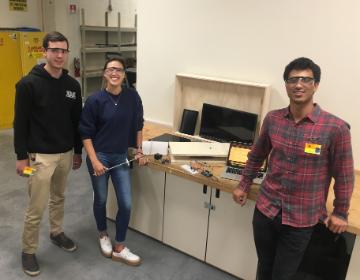Getting “WeighstEd” for the Good of SCU

Sustainability is a big deal on the Santa Clara University campus. Regularly recognized as one of the nation’s Top 50 Green Colleges (Princeton Review) and among the Sierra Club’s Top 50 Cool Schools, SCU is dedicated to promoting a culture of sustainability among its students, faculty, and staff. Among other goals, the University has committed to a ten percent reduction in food waste by 2020, but to do so the Center for Sustainability needs a reliable system to measure progress. Enter a team of mechanical engineering seniors: Vince Heyman, Timothy Jaworski, and Tatianna Schleup stepped up to aid the effort.
Some measures were already in place—pre-consumption composting of scraps made during meal preparation, and leftovers packaged and delivered to a local soup kitchen. But heaps of food were still being tossed into dining hall trash cans. One problem, Tatianna explained, was that the Center for Sustainability had no clear idea how much food was being tossed out. “The collected data is not 100 percent consistent, and the Center has to rely on volunteers to do the work,” said Tatianna.
For their senior design project, the team offered to create a standalone device for the Center for Sustainability to install in the dining hall. They started by surveying fellow students to gauge their willingness to spend an extra ten to fifteen seconds after a meal. “We got a lot of support for the project through the survey,” said Timothy, “and we learned that students want to get a more personal view of their impact regarding food waste.” Survey feedback influenced several design decisions, such as including an LCD screen providing real-time data on precisely how much food was being wasted and which station in the dining hall was creating the most waste.
Advised by mechanical engineering Associate Professor Tim Hight and Center for Sustainability Director Lindsey Kalkbrenner, the team went through a slew of iterations before landing on their final design, which had to cost less than $1,500. “At first,” Vince said, “we had an idea for a robotic arm that would scrape food onto a scale, from which a squeegee would push the food into the bin. That was too messy and too complicated. We decided to make the process as quick, simple, and close to what students were currently doing as possible. So we scrapped the robotics and moved the scale to below the wastebin, which reduces messiness.”
The end result is “WeighstEd,” an ADA-accessible, fully enclosed, Arduino-controlled, mobile receptacle that is about three feet high. A tablet installed atop the lid is preloaded with station offerings and meal information, allowing users to select the particular items they are discarding. The inputted data runs a code that opens the lid to allow users to scrape in their food, takes a scale reading, and feeds back information to Google sheets and forms to update trends on which meals and stations are creating the most waste.
“It was a steep learning curve with the computer coding we had to do,” Timothy said. “This could have been an interdisciplinary project, but we all felt confident in our ability to learn what we needed to know.” Rather than creating an Android app, they chose to use Google sheets and forms so Center for Sustainability staff could more easily use the data. “They will be able to see the trends,” said Vince, “and let Dining Services know if they need to adjust portion sizes or change their offerings in other ways. Having this data available quarter to quarter will allow the Center to determine if SCU is reaching our goal of a ten percent reduction in food waste.”
Tatianna summed up the team’s motivation. “We all really wanted to work on something for our senior design project that would make an immediate impact. Working on this project for the Center for Sustainability has kept us motivated and invested, because we all care about sustainability at SCU and we are personally invested in it.”
Learn more about sustainability at SCU: scu.edu/missionsustainable